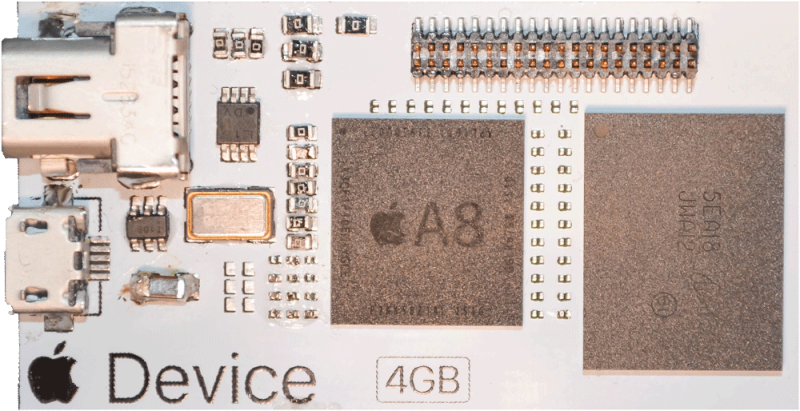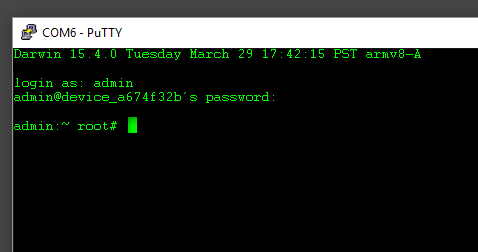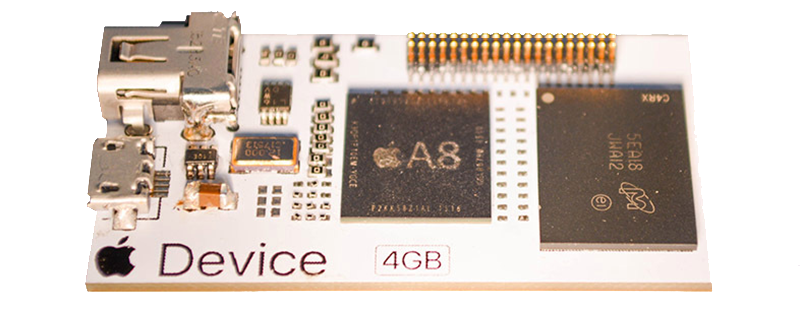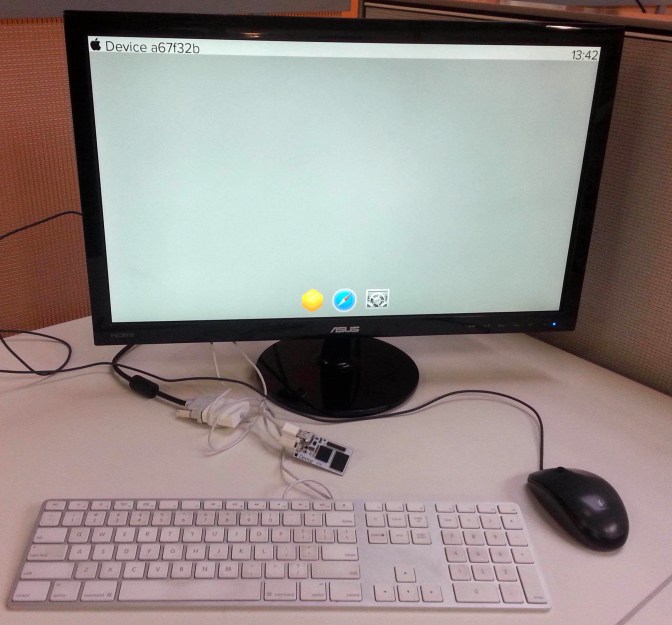Today, Apple has announced their latest bit of hardware. Following in the tradition of the Raspberry Pi, BeagleBone, and the Intel Edison, Apple have released a single board computer meant for embedded and Internet of Things applications. It’s called the Apple Device, and is sure to be a game changer in the field of low-power, Internet-enabled computing.
First off, some specs. The Apple Device uses Apple’s own A8 chip, the same dual-core 64-bit CPU found in the iPhone 6. This CPU is clocked at 1.1 GHz, and comes equipped with 1GB of LPDDR3 RAM and 4GB of eMMC Flash. I/O includes a Mini DisplayPort capable of driving a 4k display, 802.11ac, Bluetooth, and USB. In a massive break from the Apple zeitgeist of the last decade or so, the Apple Device also includes a forty pin header for expansion, much like the Raspberry Pi, BeagleBone, and Edison.
Although Apple’s first foray into the embedded computing market is a shocker, in retrospect it should come as no surprise; the introduction of HomeKit in iOS 9 laid the groundwork for an Internet of Apple Devices, embedded into toasters, refrigerators, smart homes, and cars. The Apple Device lives up to all these expectations, but what is the hands-on experience like?
See our review of the Apple Device after the break.

The first question anyone should ask when discussing an Apple Internet of Things board is, ‘what operating system does it run?’ This is, by far, the most pressing concern – you don’t need a purely graphical OS with a headless machine, and you don’t want an OS that is locked down with proprietary cruft.
Of course. the idea that Apple is built upon proprietary and locked down operating systems is a myth. iOS and Mac OS are built on Darwin, an open source kernel based on BSD. This is the core of the DeviceOS, and booting the device (through a terminal, no less!) provides everything you could ever need in a tiny, single board computer.
Apple isn’t committing themselves to a purely command line board here, though. Apple hasn’t built a computer like that for more than 30 years. There’s a Mini DisplayPort on the Apple Device, and of course that means a GUI. It’s obviously not as capable as the full feature OS X, but it is very useful. It’s not iOS, either; I’d compare it to a Chromebook – just enough to do the job, and not much else.
User Experience

While the Apple Device is intended to run headless most of the time, in fact it’s how Apple expects you to set this device up.
To power the device, all you need to do is connect the Device to a computer and open up a terminal. This drops you into the Device’s shell, with access to the entire unix-ey subsystem. Once the WiFi credentials are set, just unplug the device from the computer, plug it into a micro USB charger, and the Device is connected to the Internet.
This USB port isn’t just for power – it’s also the way to connect keyboards, mice, peripherals, and USB thumb drives. You will, however, need the Apple Powered Device USB Hub (sold separately), that breaks out the USB into four USB Type A ports while backpowering the Apple Device. It’s a brilliant physical user interface for a device that will run headless most of the time, but still requires a few ports to be useful.
Of course, if you’re not running the Apple Device headless, you’ll need to connect a monitor. This is where the Mini DisplayPort comes in. Boot the device with the Powered Device USB Hub, plug in a monitor, and you’re presented with a ‘desktop’ that’s not really OS X, and it’s not really iOS, either. It’s minimal, and almost chromebook-esque.
The OS looks a little bit like OS X, but it’s not. Right now, the only programs available for the DeviceOS are the HomeKit app, the Safari browser, and playing around with the settings. If you want to look something up on the Internet, just click on the Safari icon. If you want to change the WiFi address or the device name, just go into the settings.
Configured as a Desktop, you can see the brilliance of Apple in the Device. It’s not a desktop computer, but neither is a Chromebook. Considering most people can do most of their work on the web, this is a game-changing device. Combine it with Apple’s iCloud, and you have something that will be exceptionally popular.
The Downside of Apple
Apple has their hands in a lot of cookie jars. The Apple TV is their device for streaming videos and music to a TV. Giving the Apple Device this functionality would cut into sales of the Apple TV. Since the Apple Device sells for $100 less than the Apple TV, this would be a bad move, even if Apple is sitting on Billions in cash.
Also, even though the Apple Device has a 40-pin header right on the board, there is no documentation anywhere of what these pins can be used for. The Raspberry Pi’s 40-pin header is well documented and can be used for everything from environmental sensors to VGA and audio output. Apple makes no mention of what these pins can do, although we do expect a few ‘shields’ to be released in short order.
Benchmarks
Built around the Apple A8 chip, the Apple Device is extremely capable, especially compared to its assumed competitors, the Raspberry Pi and Intel Edison.



In terms of raw horsepower, the Apple Device handily beats out the Raspberry Pi 2 and the Intel Edison. This should be expected. The A8 chip in the Apple Device is extremely powerful and beats the other single board computers handily.
But what about graphics? The GPU in the Raspberry Pi is a huge reason why that board is popular, and being able to stream a few movies to the Apple Device would mean the Apple TV will be quickly taken out of production.
3D acceleration is better, but when it comes to h.264 encoding, the Apple Device falls a little short. Even compared to the rather sluggish Raspberry Pi Zero, the Apple Device is no match for the berry boards.
This is purely speculation, but I suspect h.264 encoding is disabled in the Apple Device. The reason is clear – Apple already sells a single board computer meant for streaming video to a TV. Giving the Apple Device the same capabilities as the Apple TV would cut into that market. Sadly, it looks like the video capabilities of the Apple Device are limited to digital signage. That’s disappointing, but given Apple’s strategy for the last twenty years, not unexpected. We do look forward to the eventual hack, root, or exploit that will unlock the powerful graphics capabilities the A8 chip already has.
Verdict
Right off the bat, the Apple Device is an amazing piece of hardware. It’s incredibly small, has a lot of computational power, and works with all the HomeKit devices you already own. The ability to just plug it into a computer and have a tiny *nix device connected to the Internet is great, and comparing the user interface to the Raspberry Pi, Beaglebone, or any of the Intel offerings isn’t even a fair comparison. Apple has taken the best design from their entire product line that anyone – including engineers and the tech literati – would find useful.
However, there are a few glaring limitations of the Apple Device. h.264 decoding is a big one, as the most popular use case of the Raspberry Pi seems to be setting up retro game emulators and streaming video from a network. Apple does what Apple will do, and the Device would probably cut into the market for the Apple TV.
Another shortcoming is the issue of the 40-pin header. Right now, there is no documentation whatsoever for the very small pin header located on the board. I couldn’t find anything in the *nix system relating to peripherals that might be connected to those pins. In any event, the pins are on a 1.0 mm pitch, making it very hard to plug a scope or meter onto one of those pins if you don’t have the mating connector. If anyone has seen this connector in the wild, I’d love to hear about it in the comments.
What Apple has done here is no different from the Raspberry Pi or any of the other ARM-powered single board computers released in recent years. They’ve taken a CPU from a smartphone that is now a few years old, added a few peripherals, and slapped it on a board. By itself, this is nothing new. That’s exactly what the Raspberry Pi is, and what all of the Raspberry Pi ‘clones’ are, from the Banana Pi to the Odroid.
While the hardware is somewhat predictable, the software is where this really shines. It’s not built for iOS, given this device is designed to run headless most of the time. It can be used purely through a command line, making this the perfect device for the Internet of Things. It’s also a tiny desktop computer, and somewhat usable given the power of the A8 chip. Since the Apple Device sells for about $50, Apple really hit it out of the park with this one, despite the obvious and not so obvious shortcomings. We’re really looking forward to Apple taking the popularity of the Raspberry Pi and other single board computers to the next level, and this is the device that will do it.
As a quick aside, it should be noted the Apple Device is technically Apple’s second single board computer. The first Apple product, the Apple I, released in 1976, would today fall into the same market as the Raspberry Pis, Beaglebones, and now the Apple Device. If you take the launch of the Apple I to be the date Apple was founded (April 1, 1976), today is the 40th anniversary of the first Apple product. The Apple I is now a museum piece and the finest example of Apple’s innovation over the years. The Apple Device follows in this tradition, and is nearly guaranteed to be held in as high regard as the board that came out of the [Steve]s’ garage.




















April 1st :D
Dammit I read the whole article like a fool
Ug, me too.
Me too! I was about to rant on the crappy power connection, lol!
Another thing that made me doubt is lack of any network connectivity information in the article or network hardware on the photo. But it did take me some time to realize that’s it is an April 1st joke.
I got skeptic when the article said it was only $50. Then I looked it up on google and nothing else popped up. So those two things ruined it for me
Not me! But im reading your comments. The board looked fake, no way two BGA chips will be on a board with minimal components. And apple doesnt use big ol SOIC packages they use the smallest components available.
I was going to say something about using all 0 ohm resistors and that being the worst soldering i have ever seen. Glad I only looked at the picture and not read the whole thing.
You men it’s not real? :(
I made it as far as “Device OS” apple wouldn’t touch anything that could be remotely construed into “DOS” with a ten foot pole.
I’m not falling for your shit brian!
Build quality is sh*t, ain’t apple, sorry :-) besides they would NEVER do this!
He said a few weeks ago he had found an ebay seller reputedly selling the A8 chips and bought one. Id put money on that chip being the one in these photos which males this an april 1st joke weeks in the making.
Damn it! I was concocting a scathing post when I realised the date!
If it were to be real, they’d call it the Apple Core, the Apple Leaf, or the Apple Seed, not the Apple Device.
It’s (supposed to be) a single board development computer, obviously it would have been the Apple Pi, but that would have given it away.
How was it powered? that was the first thing I looked at. Then no lights? seriously, no power led, 10 out of 10 times no power led its a fake.
Good one! Near have me fool if I wasn`t looking at the date!
Nice try
What a stupid April Fool.
Seconded.
Given the date, I read this in the basis of it being an April Fool, bit it’s quite a nicely done one – not that I’d expect less from Hackaday: A nice hardware work up, and some screenshots of the supposed UI.
Nicely entertaining.
I guess calling it the “Apple Pi” was just too obvious?
HA! +999
SALTmark.
And we shall call it the Apple PI
Better Appril Pi
If they do come out with something like this it would follow there pricing and would be about $400-$500.
And they would lock everything down.
Happy April 1st like per said….
Also it it would have ONLY proprietary connectors (no USB connector).
The going apple trend is to remove all connectors.
It would have only one USB-C port, half the RAM and storage of the RasPi 2, no SD card for expansion, no buttons or LEDs, no networking capability, and requires the new Macbook connected to it at all times to function.
And it won’t work with any USB-C cable, it has to be an Apple USB-C cable.
Oh My god that is so true.. I love it.
If the going price is $300 I’ll take 3.
Here is my credit card info right now.4265 7122 1234 9876 exp: 0910 #666
every one can have one. go for it. and good luck…..
Oh one more thing you have to put it together your self..
Don’t forget about the built in battery…
Exp 0910? Nice try.
@mcnugget: Joke is on your though.
And they’d take half the market overnight….
You would also have to wait in line at the local Apple store to get one.
Well done!
Funny date to introduce such a product…
Well Apple was founded on April 1st 1976 so it would not be that strange. The poor build quality and lack of ‘i’ in front of Device was the real give away to me.
You will be surprised to learn that the Apple Watch does not have an i in front of it….
But there is a china company on AliExpress that does sell stickers to make it an iWatch.
“the Apple Device sells for about $50” You must be kidding!!!!… and yes, then I noticed you were kidding. :D
If not for the obviously hand-soldered board and the fact that it is somehow powered by the keyboard alone in the “desktop” photo, I’d be willing to believe it wasn’t just an April Fool’s joke. Oh well, it actually sounds like a great concept.
Commenting without reading ?
‘ You will, however, need the Apple Powered Device USB Hub (sold separately), that breaks out the USB into four USB Type A ports while backpowering the Apple Device.’
No, I saw that. I also saw no such device in the relevant photo.
But hey, you can believe this April Fool’s joke if you want, it is very well done.
I am just dissapointed they used the raspberry pi 2 performance rather than pi 3
Ha. I really appreciate how much work you put into making this look real!
Lack of rounded corners was a tip off though ;) Nice try!
That ‘toilet white’ had me convinced!
Yeah it is something else in terms of ugly. Interestingly, most Apple PCBs these days are black or blue
They almost had me (due to the convincing board shots) until they said ‘Micro USB’ and then I knew it wasn’t Apple.
Yeah, if they’d gone with USB Type-C, they’d probably have had a pretty convincing prank going.
So much effort wasted. Should’ve probably gone with another company.
Yeah… nice effort guys, but you should have left the keyboard and mouse out of the photo. They’re not plugged into the “Device”.
The monitor has USB ports, and acts as a hub.
I should get one of those…
I think it’s just the keyboard and a monitor. I think that’s what makes the picture magical. The mouse and power … uuh?
Can you program without a Developer-ID? :D :D :D
Yeah you got me
Regardless of it being a joke, now I want to have it, what hardware is it running now?
Good one, Sir!
“You will, however, need the Apple Powered Device USB Hub (sold separately)”
LOL :)
You got me!
I was expecting to see Raspberry Pi Zeroes available at costs, endless supplies and sold with out no other accessories required.
first thing I noticed from picture one were the zero ohm resistor values and poor component placement, soldering. I was thinking ” this is either a big joke or Apple has REALLY let it’s quality go to hell”. Forgot all about it being April fools Day.
Damn good write up though, let’s see how far this spreads……
Well, I *wish* it was real…
Seems this isnt the only joke they are playing, or my coffee has been spiked with something.
April Fools!!
that’s a god awful shoop.
Photoshop of the pins and ‘4GB’ unfortunately gave it away for me at a glance, but I applaud the attention to detail. Leaving off a PCB antenna, and benchmark figures for the Edison were a bit sloppy though!
Inappropriate joke, guys(/gals) come on.
Device in Putty is a674f32b
Device in photo is a67f32b
Silly mistake Brian ;)
I really hate 1st April.
You can’t benchmark graphics without a working graphical benchmarking app running, article notes only a couple things you can do with graphics. That and there was no $5 million kickoff with multiple geniuses touting its features. And no brushed aluminum iCase available. Programming only via Apple products most likely too. iClosed Source.
It’s 10:53pm 1 April here in Aus.
I was sooo close to making it through the day without been fooled.
Well done.
I’d buy one :lol:
Wasn’t quite fooled, I did open it in another tab thread, but another comment on another page cemented it as being a fake. That being said, pole would make a killing on doing something like that…
Damn that’s evil…
Like a girlfriend telling you she’s pregnant or your dad having cancer on april 1st…
Nicely done! Enjoyed this!
0 ohm resistor? XD
Good God Brian, careful now! ;)
http://boingboing.net/2005/09/14/gillettes-5blade-raz.html
At least they didn’t steal this concept from Xerox Parc.
If Apple was really selling this, it would be like $900.
I think maximum half of this.- for $900 they “already” sell complete iPhones. But of course, $50 is not realistic, they sell only cables for this amount.
I also enjoyed that detail. Brian really played the long game on this one. Well done!
So much for Foool’s day
Introducing the iP
So, is the A8 chip actually soldered to the board or did you just glue it down? :D
Did you get paid, Brian, to write this?
Or checks don’t get approved on April 1st ;)
I can’t believe I actually believed this
I hate you guys. I just spent the last 45-60min getting mad at apple for doing this, then I decided to see what the coments had to say.
The tipping point was going to the apple website, trying to find it.
Actually Brian (almost) announced this ;-) http://hackaday.com/2016/01/24/hackaday-links-january-24-2016/
—quote–
About a month ago, a search of AliExpress turned up Apple’s A8 CPU. I bought one. Here’s what I got. It’s a stupidly small pitch BGA, and I don’t have a datasheet. What am I going to do with it? Make a non-functioning board with a few ports, resistors, no traces, and the A8 chip planted square in the middle.
——
So this is what Brian Benchoff did with that A8 chip he got from China in January (with no datasheet)
http://hackaday.com/2016/01/24/hackaday-links-january-24-2016/
WOW can’t even count this as an attempt. All images were obviously all photoshopped (very poorly). Come on you could have done so much better, what a disappointment!
For those of use photographers who spend a lot of time examining photos to learn and discuss their flaws… would you care to point out what you think is “obviously” photoshopped (poorly) about the photos?
The only thing that is apparent to me is the device name mismatch between images 3 and 4. The photos of the boards appear to be real photos of a real [joke] artifact.
I’ll wait until next year when they release the slightly bigger version with the same hardware and call in a completely new product.
The best part is, wait for it, they could.
Why not?
The missing piece is the App Store.
Add App Store, and this could be real.
Specs go even further with a compiled language, and promote Swift for IOT.
The “Apple Device” is scary real.
Stop using an iPhone for your wall control panel – use Apple Device! (HomeKit is a thing I haven’t heard of, but perfect.)
Apple rely on others to make the hardware and too much hardware would be on show and then the clones would appear and that imperial death march sound and they’d try to lock and control and say they invented this and that because they filed a patent for the concept of the idea because it was in the English language, Shoddy lawyers have PC type devices and phones made APPLE think the same but different same. Time for a Bento box.